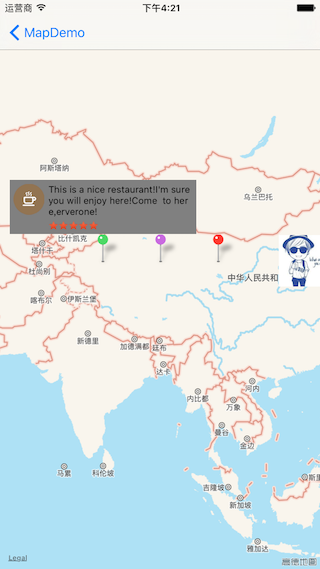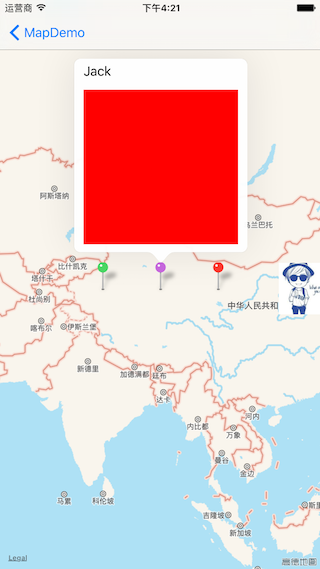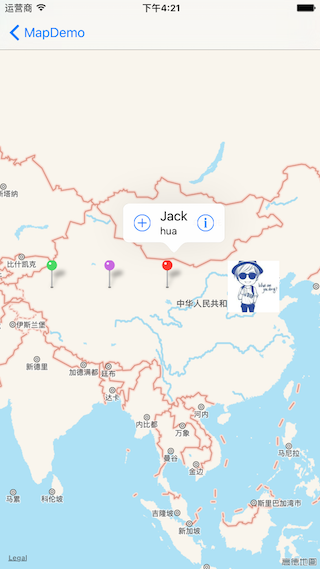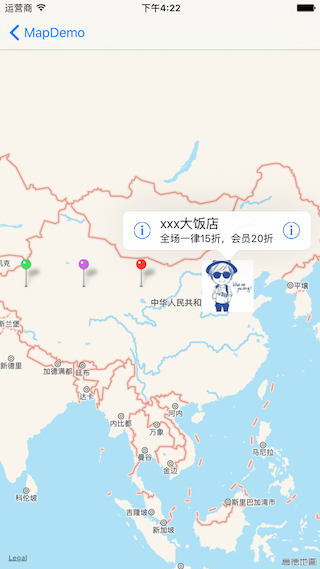1 )可以使用下列选择定义合理的大头针对象:
2 )定义大头针视图,在屏幕上显示大头针数据。怎样定义大头针视图主要取决于需求,这里有一些情况如下:
弹出视图是标准或者自定义视图显示在大头针视图上,标准的弹出视图显示大头针的 title , subtitle,image 等属性。如果想显示一个自定义视图并且行为像原生弹出框一样,可以添加自定义子视图到大头针视图并且更新大头针视图的 hit testing 方法来处理用户与子视图的交互。
当我们是使用自定义视图而不是系统标准弹出视图时,我们需要做一些额外的工作来确保弹出视图与用户交互过程中的显示和隐藏,下面是一些相关步骤来创建一个自定义弹出框包含按钮 (button) :
1 :定义一个 UIView 的子类用于显示自定义弹出框 (custom callout), 很有可能子类需要实现 drawRect: 方法来实现绘制自定义内容。
2 :创建一个视图控制器初始化自定义弹出视图 (callout view) ,并且执行与 button 相关的 action 事件。
3 :在大头针视图中,实现 hitTest: 方法来响应点击事件,点击的位子是大头针视图 (annotation view) 的外部而在弹出视图 (callout view) 的内部,具体相关代码为:
Listing 6 - 7 Responding to hits within a custom callout
- (NSView *)hitTest:(NSPoint)point
{
NSView *hitView = [ super hitTest:point];
if (hitView == nil && self .selected) {
NSView *calloutView = self .calloutViewController.view;
NSPoint pointInCalloutView = [ self convertPoint:point toView:calloutView];
hitView = [calloutView hitTest:pointInCalloutView];
}
return hitView;
}
4 :在大头针视图中实现 setSelected:animated: 方法,添加弹出视图到大头针视图上作为子视图,当用户点击大头针的视图的时候,如果弹出视图已经是可见,那么在该方法中需要去除大头针视图中的弹出视图。代码如下:
Listing 6 - 8 Adding and removing a custom callout view
- (void)setSelected:(BOOL)selected
{
[ super setSelected:selected];
// Get the custom callout view.
NSView *calloutView = self .calloutViewController.view;
if (selected) {
NSRect annotationViewBounds = self .bounds;
NSRect calloutViewFrame = calloutView.frame;
// Center the callout view above and to the right of the annotation view.
calloutViewFrame.origin.x = -(NSWidth(calloutViewFrame) - NSWidth(annotationViewBounds)) * 0.5 ;
calloutViewFrame.origin.y = -NSHeight(calloutViewFrame) + 15.0 ;
calloutView.frame = calloutViewFrame;
[ self addSubview:calloutView];
} else {
[calloutView.animator removeFromSuperview];
}
}
2:使用图片显示大头针视图,并使用自定义大头针模型、
3:自定义弹出视图、
4:适用于顶部title,底部自定义视图 ios9之后
代码部分:
class SecondViewController: UIViewController {
lazy var mapView: MKMapView = {
let mapView = MKMapView(frame: UIScreen.mainScreen().bounds)
mapView.mapType = .Standard
mapView.scrollEnabled = true
mapView.zoomEnabled = true
mapView.showsUserLocation = true
mapView.delegate = self
return mapView
}()
override func viewDidLoad() {
super.viewDidLoad()
view.addSubview(self.mapView)
addAnnotations()
}
//MARK: 添加大头针
func addAnnotations(){
//创建MKPointAnnotation对象
let pointAnnotation = MKPointAnnotation()
pointAnnotation.coordinate = CLLocationCoordinate2DMake(39, 100)
pointAnnotation.title = "Jack"
pointAnnotation.subtitle = "hua"
self.mapView.addAnnotation(pointAnnotation)
//创建自定义大头针并添加到地图上
let annotationOne = FirstAnnotation(coordinate: CLLocationCoordinate2DMake(39, 115),title:"xxx大饭店",subtitle:"全场一律15折,会员20折")
annotationOne.iconImage = UIImage(named: "boy")
self.mapView.addAnnotation(annotationOne)
//自定义弹出视图
let calloutAnnotation = <span style="font-family: Menlo; font-variant-ligatures: no-common-ligatures;">SecondAnnotation</span><span style="font-family: 'PingFang SC';">(coordinate: CLLocationCoordinate2DMake(39, 80))</span>
calloutAnnotation.icon = UIImage(named: "icon_classify_cafe")
calloutAnnotation.rate = UIImage(named: "icon_Movie_Star_rating")
calloutAnnotation.descriptionDetail = "This is a nice restaurant!I'm sure you will enjoy here!Come to here,everone!"
self.mapView.addAnnotation(calloutAnnotation)
//使用系统自带附属视图
let detailAnnotation = DetailCalloutAccessoryAnnotation(coordinate: CLLocationCoordinate2DMake(39, 90),title:"Jack")
self.mapView.addAnnotation(detailAnnotation)
}
}
代码分析:
上面代码主要是将地图添加到当前视图控制器视图上,并添加4个大头针到地图上,自定义大头针模型对象代码如下:
//自定义大头针模型
class FirstAnnotation: NSObject,MKAnnotation {
//位置
var coordinate: CLLocationCoordinate2D
//主标题
var title: String?
//副标题
var subtitle: String?
//图片icon
var iconImage: UIImage?
init(coordinate: CLLocationCoordinate2D,title: String,subtitle:String) {
self.coordinate = coordinate
self.title = title
self.subtitle = subtitle
super.init()
}
}
//用于弹出框类型判断模型
class SecondAnnotation: NSObject,MKAnnotation {
//位置
var coordinate: CLLocationCoordinate2D
//左侧icon
var icon: UIImage?
//icon描述
var descriptionDetail: String?
//底部评分视图
var rate: UIImage?
init(coordinate: CLLocationCoordinate2D) {
self.coordinate = coordinate
super.init()
}
}
//弹出视图模型
class SHCalloutAnnotation: NSObject,MKAnnotation{
var coordinate: CLLocationCoordinate2D
init(coordinate: CLLocationCoordinate2D) {
self.coordinate = coordinate
super.init()
}
//左侧icon
var icon: UIImage?
//icon描述
var descriptionDetail: String?
//底部评分视图
var rate: UIImage?
}
//附属视图模型
class DetailCalloutAccessoryAnnotation: NSObject,MKAnnotation {
//位置
var coordinate: CLLocationCoordinate2D
//主标题
var title: String?
//副标题
var subtitle: String?
init(coordinate: CLLocationCoordinate2D,title: String) {
self.coordinate = coordinate
self.title = title
super.init()
}
//官方示例代码使用:在模型中创建大头针视图
class func createViewAnnotationForMapView(mapView:MKMapView, annotation:MKAnnotation) ->MKAnnotationView{
let identifier = "DetailCalloutAccessoryAnnotation"
var annotationView = mapView.dequeueReusableAnnotationViewWithIdentifier(identifier) as? MKPinAnnotationView
if (annotationView == nil){
annotationView = MKPinAnnotationView(annotation: annotation, reuseIdentifier: identifier)
annotationView!.canShowCallout = true
//设置大头针颜色
annotationView!.pinColor = MKPinAnnotationColor.Purple
let backgroundView = UIView(frame: CGRectZero)
backgroundView.backgroundColor = UIColor.redColor()
//添加约束才可以使用自定义视图
let widthConstraint = NSLayoutConstraint(item: backgroundView, attribute: .Width, relatedBy: .Equal, toItem: nil, attribute: .NotAnAttribute, multiplier: 1, constant: 200)
backgroundView.addConstraint(widthConstraint)
let heightConstraint = NSLayoutConstraint(item: backgroundView, attribute: .Height, relatedBy: .Equal, toItem: nil, attribute: .NotAnAttribute, multiplier: 1, constant: 200)
backgroundView.addConstraint(heightConstraint)
if #available(iOS 9.0, *) {
//赋值UIImageView直接可以使用
//returnAnnotaionView!.detailCalloutAccessoryView = UIImageView(image: UIImage(named: "icon_classify_cafe"))
//直接赋值UIView,UILabel等视图不行?http://stackoverflow.com/questions/32581049/mapkit-ios-9-detailcalloutaccessoryview-usage 因为我们需要对宽和高做约束
annotationView!.detailCalloutAccessoryView = backgroundView
} else {
print("iOS9以下系统暂时不能够使用!")
}
}
return annotationView!
}
}
接下来,继续看一下视图控制器中的代码,我通过extension实现协议内容:
extension SecondViewController:MKMapViewDelegate{
//显示大头针时调用,注意方法中的annotation参数是即将显示的大头针对象.1)该方法首先显示大头针的时候会调用2)向地图上添加大头针的时候也会调用
func mapView(mapView: MKMapView, viewForAnnotation annotation: MKAnnotation) -> MKAnnotationView? {
var returnAnnotaionView:MKAnnotationView?
if !(annotation.isKindOfClass(MKUserLocation)){//根据模型进行分类
if annotation.isKindOfClass(MKPointAnnotation.self){
//MARK:使用系统样式大头针视图和系统大头针模型
let identifier = "MKPinAnnotationView"
var returnAnnotaionView = mapView.dequeueReusableAnnotationViewWithIdentifier(identifier)
if (returnAnnotaionView == nil){
returnAnnotaionView = MKPinAnnotationView(annotation: annotation, reuseIdentifier: identifier)
returnAnnotaionView!.canShowCallout = true
returnAnnotaionView!.calloutOffset = CGPoint(x: 0, y: -10)
returnAnnotaionView!.leftCalloutAccessoryView = UIButton(type: .ContactAdd)
returnAnnotaionView!.rightCalloutAccessoryView = UIButton(type: .DetailDisclosure)
}else{
returnAnnotaionView!.annotation = annotation
}
return returnAnnotaionView
}else if annotation.isKindOfClass(FirstAnnotation.self){
//MARK:使用图片显示大头针视图,并使用自定义大头针模型
returnAnnotaionView = SHAnnotationView.annotationViewWith(mapView, reuseIdentifier:"SHAnnotationView")
returnAnnotaionView!.annotation = annotation
return returnAnnotaionView
}else if annotation.isKindOfClass(SecondAnnotation.self){
let identifier = "Annotation"
var returnAnnotaionView = mapView.dequeueReusableAnnotationViewWithIdentifier(identifier) as? MKPinAnnotationView
if (returnAnnotaionView == nil){
returnAnnotaionView = MKPinAnnotationView(annotation: annotation, reuseIdentifier: identifier)
returnAnnotaionView!.pinColor = MKPinAnnotationColor.Green
}
returnAnnotaionView!.annotation = annotation
return returnAnnotaionView
}else if annotation.isKindOfClass(SHCalloutAnnotation.self){
//MARK:自定义弹出视图
returnAnnotaionView = SHCalloutAnnotationView.calloutAnnotationViewWith(mapView)
returnAnnotaionView!.annotation = annotation
return returnAnnotaionView
}else if annotation.isKindOfClass(DetailCalloutAccessoryAnnotation.self){
//MARK:适用于顶部title,底部自定义视图 ios9之后
returnAnnotaionView = DetailCalloutAccessoryAnnotation.createViewAnnotationForMapView(mapView, annotation: annotation)
returnAnnotaionView!.annotation = annotation
return returnAnnotaionView
}
}
return returnAnnotaionView
}
//选中大头针时触发
func mapView(mapView: MKMapView, didSelectAnnotationView view: MKAnnotationView) {
//点击大头针模型为SecondAnnotation时,添加自定义弹出视图的大头针到地图上。
if let annotation = view.annotation{
if(annotation.isKindOfClass(SecondAnnotation.self)){
let annotation = annotation as! SecondAnnotation
let calloutAnnotaion = SHCalloutAnnotation(coordinate: annotation.coordinate)
calloutAnnotaion.icon = annotation.icon
calloutAnnotaion.rate = annotation.rate
calloutAnnotaion.descriptionDetail = annotation.descriptionDetail
mapView.addAnnotation(calloutAnnotaion)
}
}
}
//反选时触发
func mapView(mapView: MKMapView, didDeselectAnnotationView view: MKAnnotationView) {
for annotation in self.mapView.annotations {
if annotation.isKindOfClass(SHCalloutAnnotation.self){
dispatch_async(dispatch_get_main_queue(), {
mapView.removeAnnotation(annotation)
})
}
}
}
}以及自定义视图部分:
//边距
public let CalloutBorderSpace:CGFloat = 5
//MARK:自定义大头针视图
class SHAnnotationView: MKAnnotationView {
class func annotationViewWith(mapView: MKMapView,reuseIdentifier:String) ->SHAnnotationView{
//从缓存池中取出可以循环利用的大头针view
var annotationView = mapView.dequeueReusableAnnotationViewWithIdentifier(reuseIdentifier) as? SHAnnotationView
if annotationView == nil{
annotationView = SHAnnotationView(annotation: nil, reuseIdentifier:reuseIdentifier)
annotationView?.canShowCallout = true
annotationView?.leftCalloutAccessoryView = UIButton(type: .InfoDark)
annotationView?.rightCalloutAccessoryView = UIButton(type: .DetailDisclosure)
}
return annotationView!
}
override var annotation: MKAnnotation?{
didSet(annotation){
//显示大头针为图片
if let annotationOne = annotation as? FirstAnnotation{
self.image = annotationOne.iconImage
}
}
}
}
//MARK:弹出视图 继承于MKAnnotationView进行显示视图
class SHCalloutAnnotationView: MKAnnotationView{
//#MARK:使用懒加载声明需要的控件属性
lazy var leftIcon:UIImageView = {
let leftIcon = UIImageView()
self.addSubview(leftIcon)
return leftIcon
}()
lazy var detailLabel:UILabel = {
let detailLabel = UILabel(frame: CGRectZero)
detailLabel.lineBreakMode = .ByCharWrapping
detailLabel.font = UIFont.systemFontOfSize(12)
detailLabel.numberOfLines = 0
self.addSubview(detailLabel)
return detailLabel
}()
lazy var rateIcon:UIImageView = {
let rateIcon = UIImageView()
self.addSubview(rateIcon)
return rateIcon
}()
var button:UIButton!
//#MARK: 创建弹出视图
class func calloutAnnotationViewWith(mapView: MKMapView)-> SHCalloutAnnotationView{
let indentifier = "SHCallOutAnnotationView"
var calloutView = mapView.dequeueReusableAnnotationViewWithIdentifier(indentifier) as? SHCalloutAnnotationView
if calloutView == nil{
calloutView = SHCalloutAnnotationView()
calloutView!.backgroundColor = UIColor.grayColor()
}
return calloutView!
}
//#MARK:赋值数据模型显示相应的数据
override var annotation: MKAnnotation?{
didSet(callOutAnnotation){
if let callOutAnnotation = callOutAnnotation as? SHCalloutAnnotation{
self.leftIcon.image = callOutAnnotation.icon
self.leftIcon.frame = CGRect(x: CalloutBorderSpace, y: CalloutBorderSpace, width: callOutAnnotation.icon!.size.width, height: callOutAnnotation.icon!.size.height)
self.detailLabel.text = callOutAnnotation.descriptionDetail
let string:NSString = self.detailLabel.text!
let detailLabelSize = string.boundingRectWithSize(CGSize(width: 200,height: 200), options:.UsesLineFragmentOrigin, attributes: [NSFontAttributeName: self.detailLabel.font], context: nil)
self.detailLabel.frame = CGRect(x: CGRectGetMaxX(self.leftIcon.frame) + CalloutBorderSpace, y:CGRectGetMinY(self.leftIcon.frame), width: detailLabelSize.width, height: detailLabelSize.height)
self.rateIcon.image = callOutAnnotation.rate
self.rateIcon.frame = CGRect(x: CGRectGetMinX(self.detailLabel.frame), y: CGRectGetMaxY(self.detailLabel.frame) + CalloutBorderSpace, width: callOutAnnotation.rate!.size.width, height: callOutAnnotation.rate!.size.height)
self.bounds = CGRect(x: 0, y: 0, width: CGRectGetMaxX(self.detailLabel.frame) + CalloutBorderSpace, height: CGRectGetMaxY(self.rateIcon.frame) + CalloutBorderSpace)
//注意:确定最终的显示位置
self.centerOffset = CGPointMake(0, -self.bounds.size.height)
}
}
}
//#MARK:当弹出视图显示的时候添加缩放动画
override func didMoveToSuperview() {
let animation = CAKeyframeAnimation(keyPath: "transform.scale")
animation.values = [0,1.5,1,1.5,1]
animation.duration = 0.5
self.layer.addAnimation(animation, forKey: nil)
}
}代码分析:
我们之前已经添加了4个大头针到地图,当显示大头针的时候,会触发mapView(mapView:MKMapView, viewForAnnotation annotation:MKAnnotation)方法获取大头针视图,我们根据所添加的大头针模型进行分类返回对应的大头针视图。
对于显示使用系统样式大头针视图和系统大头针模型、使用图片显示大头针视图,并使用自定义大头针模型、ios9之后出现的附属视图的属性等都很简单,直接看代码就好。主要分析一下是如何实现callout视图的:
首先是添加一个大头针到视图上,当该大头针被点击的时候,添加我们自定义的大头针SecondAnnotation对象,所有数据都是源于原大头针模型,然后会触发mapView(mapView: MKMapView, viewForAnnotation annotation: MKAnnotation)方法,进行添加我们自定义的callout视图。并赋值annotation数据,显示整个视图。
实现效果图如下:

























 4483
4483

 被折叠的 条评论
为什么被折叠?
被折叠的 条评论
为什么被折叠?








